Sep 1, 2024 – 2nd Day of JTS Workshop in Bhutan, Dharma Propagators’ Assembly
Hello. Today is the second day of the JTS workshop on ‘Sustainable Development’ held in Zhemgang, Bhutan.
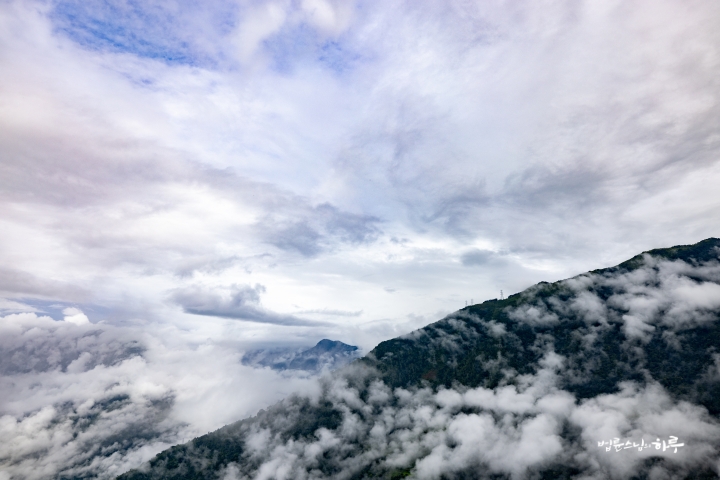
After completing his morning practice and meditation, Sunim connected online to the Dharma Propagators’ Assembly at 6 AM. This is the fourth Dharma Propagators’ Assembly since the start of the Second 10,000-Day Practice.

The Dharma Propagators’ Assembly began with about 2,100 leading members from home and abroad entering the video conference room. After the assembly paid respects to Sunim with three bows, requesting his teaching, Sunim gave the opening Dharma talk.

At the midpoint of Jungto Society’s Second 1000-Day Practice, Sunim evaluated the past 500 days and spoke about what the Dharma propagators should focus on discussing today.

“I am currently in Bhutan. In Zhemgang, central Bhutan, local government officials have gathered to discuss the principles and methods for implementing pilot projects for sustainable development. Although I’m far away, thanks to the online system, I can participate in the Dharma Propagators’ Assembly.
The Path to Lead All People in the World to Happiness
When Jungto Society began the First 1000-Day Practice during the Second 10,000-Day Practice, we set two major goals: ‘Spreading the Dharma around the world’ and ‘Spreading the Dharma to young people’. We’ve seen some success in spreading the Dharma to young people, with an increase in enrollment for the Jungto Dharma School. However, our efforts to spread the Dharma globally have been somewhat lacking due to a focus on content development. With the advent of AI-powered automatic translation, we may be able to create more content for global Dharma propagation faster than we initially thought. Initially, we considered Western countries like the United States and Europe as our main targets for global Dharma propagation. However, after visiting various regions in Southeast Asia last year and this year, I realized that even in Buddhist countries, many people don’t truly understand the Buddha’s teachings. This made me aware of the great need to spread the correct Dharma in these areas as well. So, the scope of our global Dharma propagation has expanded to include Southeast Asia.

Globally, the climate crisis is accelerating to a serious degree, and conflicts are growing in various parts of the world. Of course, the security situation on the Korean Peninsula is also becoming increasingly dangerous, to the point where it could lead to war. In times like these, we need to create a new civilization that overcomes consumerism and responds to the climate crisis through global Dharma propagation. We must work to establish peace to prevent the horrors of war from occurring again on the Korean Peninsula. There are still many people in the world suffering from absolute poverty. When visiting conflict zones, we see children unable to receive even elementary education. Therefore, we must continue our efforts to eradicate absolute poverty and illiteracy with a sense of humanity.
Globally, human nature is becoming increasingly harsh, communities are disintegrating, and people are suffering more. Despite the high development of material civilization, human suffering is increasing rather than decreasing. Looking at the current situation, it seems there is no alternative to the Buddha’s teachings for restoring humanity. The more I travel around the world, the more I realize that the only way to lead all people to happiness – regardless of whether they are rich or poor, from developed or underdeveloped countries, regardless of age or gender – is to convey the Buddha’s correct teachings to them. When people hear the Buddha’s teachings and begin to practice, not only do they become happy themselves, but they also become able to share their talents with those in need. This strengthens my conviction that we must walk the path of peace and stability together.

How to Revitalize by Reinforcing Offline Activities
Looking at these situations overall, we can see that the direction set by Jungto Society is desirable. However, our current reality is that we are not progressing as much as we had aimed for. Five years ago, we overcame the crisis by introducing online methods in response to the COVID-19 pandemic, but in the process, we failed to properly conclude the first 10,000-Day Practice. As the membership system changed, many regular members were unable to transition to leading members and reverted to general members. While the shift to online activities brought more vitality to younger volunteers, middle-aged and older volunteers became more withdrawn. In particular, elderly volunteers became almost unable to participate. Sunim’s Dharma Q&A sessions, which used to be fun and lively when held offline, have become more widely spread online but seem to have lost much of their enjoyment and vitality. This phenomenon is evident in Jungto Society’s overall activities.
This shows that transitioning our offline activities to online platforms is not easy. Now that the COVID-19 pandemic has ended, we should consider supplementing the areas that were lacking in the online transition with offline activities. Therefore, the first method to overcome the current stagnation is to expand offline activities somewhat to inject vitality.
Developing Operational Methods More Suitable for Online Platforms
The second method is to develop practical activities and operational methods that are more suitable for online platforms. Currently, Jungto Society’s operational methods and practical activities are merely transplants of offline programs to online platforms, rather than being developed as online-specific practices and operational methods. This is because online operational methods are a new endeavor that no one has experienced before.
In the long term, we need to change our entire operational system to suit online platforms. However, we cannot do this immediately because no one has experience in this area. Therefore, for the time being, we need to reinforce offline activities to inject vitality in order to overcome the stagnation that occurred during the transition to online platforms. It’s not a matter of choosing one or the other, but rather we should first reinforce offline activities to inject vitality, and in the long term, find new operational methods suitable for online systems.
Of course, it might be more effective if I directly led these efforts in Korea. However, we must keep in mind the goal of the second 10,000-Day Practice, which is spreading the dharma around the world. For this purpose, rather than spending a lot of time in Korea, I need to use my experience to pioneer new projects. I believe it’s better for Jungto Society’s future development if I invest more time in pioneering global dharma propagation, such as creating sustainable development models to prepare for the climate crisis era and launching poverty eradication movements in various countries around the world. That’s why I’m spending a lot of time abroad now. I can travel around the world like this because you, the leading members, are taking charge of domestic dharma propagation and working hard.

At today’s Leading Members’ Assembly, many new alternatives to overcome the stagnation will be proposed. If these are added to what we’re already doing, it could increase the burden and potentially exhaust you, making it unsustainable. So, please have extensive discussions not only about the direction we should pursue but also about the method – whether it would be better to start by creating a separate organization, or whether it would be more effective to concentrate our efforts in one place, as has always been effective throughout Jungto Society’s history when everyone worked together.”
Sunim then declared the opening and proceeded to the main session. The leading members spent the entire day on reports and evaluations of the past half-year’s activities, Q&A sessions, and group discussions by branch on proposals for special practices.


After finishing the opening Dharma talk, Sunim headed to the GEM Gangnam Startup Center in the adjacent building to attend the JTS workshop. Government officials and village leaders from five districts in Bhutan also arrived at the center and had breakfast.

After breakfast, Sunim began the second day of the workshop energetically with a keynote lecture starting at 8:40 AM. Sunim spoke in detail about the seven categories that are targets for sustainable development support.

How Can We Achieve Sustainable Development?
“JTS’s sustainable development efforts in Bhutan involve two overlapping activities. First, there are initiatives to improve the lives of people in difficult circumstances. Second, there are activities aimed at ensuring environmentally sustainable development without reckless exploitation driven by human desires in this era of climate crisis. Therefore, if you think of JTS’s work here only as relief activities for the needy, contradictions may always arise. For example, even when having a drink during activities, we don’t use disposable paper cups.
Seven Areas of Support for Sustainable Development
So what exactly is sustainable development? The following seven areas can be targets for sustainable development.

First, improving living conditions. We build houses for those without homes. For those who have homes but live in poor conditions due to poverty, we improve the facilities inside their houses. If there are no shelves inside the house, we install shelves. If smoke fills the kitchen when cooking, we improve the kitchen facilities to allow smoke to escape. If a married child lives with their parents without partitions, we install partitions. In other words, we improve the living conditions of the poorest 20 percent. If there’s a shortage of dishes or household items, we supplement those to some extent. This improvement of living conditions is the first priority. For example, in a relatively well-off village, it might be the bottom 10 percent, while in a poor village, it could be the bottom 30 percent, so there’s no fixed percentage. If you think, “That house’s living conditions are too poor,” it becomes a target for improvement. So living conditions should be improved to at least a minimum standard.
Second, improving production facilities. The most representative example is irrigation channels. We may also need to widen farm roads between rice fields to allow carts to pass. To increase agricultural production, we might need to improve seeds. Changing the methods of seedbed preparation or rice planting comes with its own challenges. Additionally, we need to build fences to prevent wild animals from invading crops and construct warehouses to store agricultural products. For example, we might distribute 10 chicks each to poor people, or provide support related to fruit farming and animal husbandry. In the case of animal husbandry, considering environmental concerns, we can support livestock farming using agricultural by-products, but large-scale livestock farming cannot be sustainable development from an environmental perspective. For instance, buying feed to raise chickens is not sustainable development. However, raising chickens on a small scale using leftover agricultural products is acceptable. So, if you have ideas for small-scale improvements that can generate some income, JTS can support them.

Furthermore, if there’s an unmarried woman who has graduated from high school in your village, we can provide her with an embroidery machine. In other words, any support that helps young people live in the area is possible. For young men who won’t engage in traditional farming, if a few of them gather to develop a farm on wasteland provided by the government, we can support them with necessary machinery or fencing. We support these farm developments for young people, but not for others, because it’s necessary to keep young people in the area. Special measures are needed to keep youth in the region. Additionally, if facilities for making compost are needed, or if facilities are required for tea cultivation, or if someone wants to grow coffee, we can consider supporting ideas that increase production. For example, we cannot support planting coffee or special crops in fields just because they’re profitable. Even if it generates more income, it would lower food self-sufficiency in Bhutan, which already lacks rice. If processing facilities can increase profits more than selling raw products, we can consider building such facilities. Besides the examples I’ve given, if you have other ideas, submit them, and we can review and decide together. For instance, we could consider how to dry and sell wild vegetables or mushrooms collected from the mountains.
Third, improving school educational facilities. While some schools may need to be closed due to lack of students, if a school needs to be maintained, we should repair old facilities like toilets, classroom floors, and desks so that children can study in a clean environment. Any improvements needed for children’s educational environment in your areas can be included in this project’s support. When I visited some schools, some children requested more laptops for the classroom or smart TVs. We can discuss and support these items if they’re appropriate for the school’s level. Moreover, most school toilets are in very poor condition, so they will need improvement in most cases.

Fourth, improving health and medical facilities. In one chiwog I visited, they requested heating equipment for the delivery room. When I asked how many babies were born last year, they said three. One was born in Thimphu, one in Trashigang, and only one at the local health center. We need to consider whether it’s necessary to support heating equipment for just one birth. Anyway, if there are any facilities needed for treating residents, please suggest them. We’ll investigate directly, discuss if it’s really necessary, and support it if approved.
Even if there’s a health center in every chiwog, there are areas where individual health difficulties can’t be resolved. We’re trying to solve problems like cataracts in the elderly that impair vision, hearing difficulties, or inability to chew food due to missing teeth. However, it seems very difficult for doctors from Korea to come here, especially to visit every village. Nowadays, even eye surgeries are done with laser machines, not by hand, but these machines are too large to bring here. So we’re considering setting up hospital facilities in Gelephu, located on the Indian border, and taking patients there for surgery.
Therefore, you need to conduct preliminary surveys in each village. You should list all household names, indicate whether they have a house or not, whether the house needs improvement, how much land they own, what their family relationships are like, how many people live together, how many have moved to other cities, how many children are in boarding schools, and so on. Age, health problems – all of these need to be surveyed for each household. This way, we can later verify and respond directly. Especially for health issues, someone working at the health center should check and list people with poor eyesight, hearing difficulties, and so on. This way, when a doctor comes, they can further check who needs surgery or treatment and take them. This only applies to areas not covered by government healthcare, as the government is already treating general patients.

Fifth, improving infrastructure. The most representative example is road improvement. Of course, building new roads or paving entire roads is the government’s responsibility. However, the government does not pave “farm roads” in rural areas. In other words, the government paves the road from the village entrance to the village center, but most roads within the village center remain unpaved. In such cases, paving just some difficult sections like steep slopes or sharp curves, rather than the entire road, can make travel much easier. For roads where water flows, burying pipes underneath and covering with cement, or creating cement waterways along the roadside allows vehicles to pass even during the rainy season. There’s also the matter of bringing drinking water from water sources. This is a big task as water often needs to be brought from 4-10 km away. If the scale is too large, it should be done by the government, but if it’s manageable for villagers to do together, it could be a JTS project.
Sixth, preserving traditional culture. The people of Nabji Chiwog perform mask dances. If they lack masks or a drum is broken, JTS can provide support. If the intention to preserve culture is clear, we can review and possibly support it. For example, we can’t simply rebuild or renovate temples on request, but if it’s an old temple in need of repair or a recognized cultural heritage worth preserving, we can provide support. If you need certain tools for performing traditional dances in your village, those can also be eligible for support.
Seventh, preserving the natural environment. Even during development, we must never damage the environment. If there is destroyed environment, restoring it can also be eligible for support. For example, every village has beautiful spring flowers on the nearby hills. Activities related to preserving these flowers, such as removing surrounding shrubs to protect them, can be supported as they contribute to preserving beautiful nature.

These are the seven categories of sustainable development projects. However, you can inquire about anything else you think might be suitable. We can review it together and determine if it’s not feasible due to environmental damage, lack of self-sustainability, or because it’s the government’s responsibility.
However, none of this is done for you by others. While you can demand things from the government because they work with your tax money, this project is funded by donations from JTS members, not your taxes. So this money can only be used for public purposes like saving the global environment or helping those in need. And support is only possible when you voluntarily participate as the main actors, saying “We will do this.”
This is the content of sustainable development that we want to do to improve the lives of residents in Zhemgang or Trongsa, Bhutan in the future.”
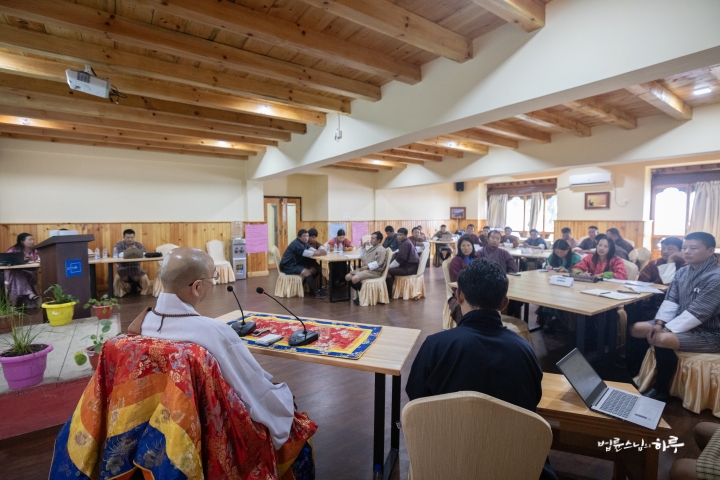
Sunim then provided guidance on eight criteria for evaluating whether sustainable development was done well or not. First, was the expense minimized as much as possible? Second, were materials produced in Bhutan used? Third, was it made using local skills? Fourth, was it made to be conveniently used? Fifth, did many people participate together? Sixth, does it benefit as many people as possible? Seventh, was the process enjoyable and rewarding even if it was difficult? Eighth, was it carried out in a way that didn’t damage the environment? He explained each point with specific examples for an hour.
After the Dharma talk, there was a Q&A session, and then Sunim introduced the discussion topic for the next session.

“In the next session, you will discuss among yourselves. Please discuss specifically what you would do for sustainable development in your village. How many houses need to be newly built, how many need interior repairs, how much farmland needs fencing, and so on. Please write down everything that you think would make your village more livable if improved to this extent. Write down everything that falls within the seven categories I just mentioned. After hearing your presentations, we’ll discuss which ones are possible, which ones aren’t, and which ones need further review.”
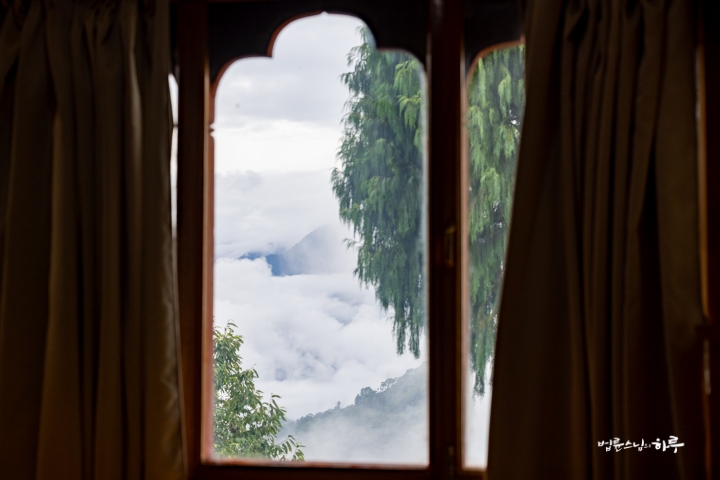
From 10:40 AM, group discussions were held by village. The participants freely discussed what they could do in their villages based on the seven items of sustainable development that Sunim had talked about.
First, in the morning, they discussed projects that could be implemented over the next three years. They took time to carefully design specific implementation plans and village workforce management plans.
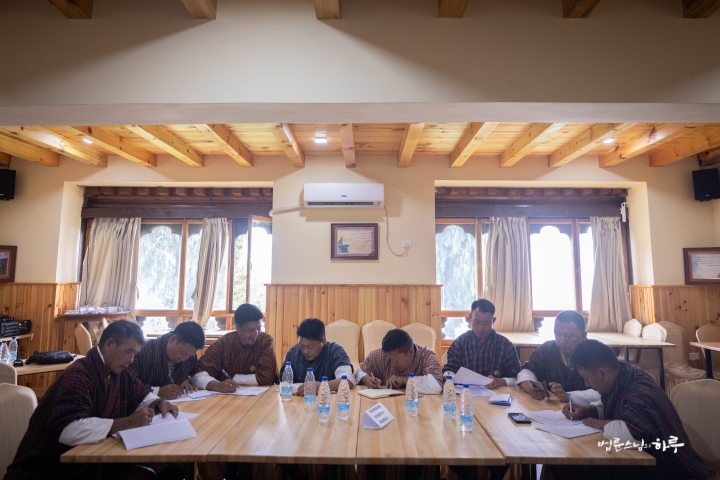


After an hour of discussion, everyone gathered again to present the results. The village representatives came forward to share what they believed was most needed in their villages.



After Kulpu Geok and Nangla Geok presented their discussion results, everyone had lunch. While everyone was eating, Sunim participated online in the closing ceremony of the Dharma Propagators’ Assembly from 1:20 PM local time, which was 4:20 PM Korean time.

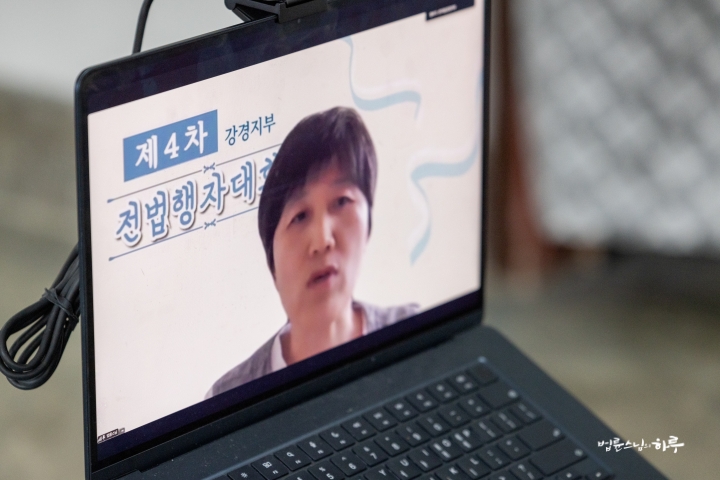
After the Dharma propagators had group discussions by branch, they gathered again for a Q&A session with Sunim. Anyone who had unresolved questions or suggestions from the discussion time could press the raise hand button and engage in dialogue with Sunim. After the Q&A, Sunim provided concluding remarks.

“Most people around me evaluate that Jungto Society is the only organization that still maintains vitality even after experiencing the COVID-19 pandemic. However, since Jungto Society is an organization that constantly pursues new changes, we should not be complacent by comparing ourselves to other organizations. We need to thoroughly examine what problems are causing the slight stagnation we feel, and if we are doing well, we can continue as we are, but if there are problems, we need to make improvements.
The most important thing for Jungto Society to move forward is the mental and physical health of each of you, the Dharma propagators. So, whether it’s through group discussions by branch or through surveys, I think it would be good to first check on your health status.

If Jungto Society wants to try something new, we need to consider a few things. First, we need to discuss whether to do it comprehensively or partially. Second, we need to carefully examine whether the new attempt will disrupt what we have achieved so far or if it will be a complementary approach. Third, we need to examine from various angles whether the problem is due to online activities, whether the program is too tightly scheduled, whether this is natural, or whether there is an error in the communication method. Fourth, I would like you to raise issues about whether this stagnant phase can be resolved through some special dedication, and whether it might lead to work overload. If the conclusion is that it’s not the right solution and only encourages work overload, it should be reconsidered. Especially since these matters relate to Jungto Society as a whole, a re-approval process by all Dharma propagators may be necessary. If more discussion is needed, we might need to hold multiple public hearings, or if opinions are divided, we might need to have more in-depth discussion time by branch. Thank you all for your hard work today.”

After concluding the Dharma Propagators’ Assembly with the Four Great Vows, Sunim returned to participate in the JTS workshop.


From 2:30 PM, Gosing Geok, Pankal Geok, and Baldo Geok presented their discussion results in order. Various projects were proposed. Among them, Budasi Cheok from Gosing Geok proposed the need for renovation work, stating that there were many things that needed repair in the temple operated by the village.

“There is a temple operated by our village. There are too many things that need repair. Especially in our village, there are people with disabilities living, but there is no bathroom for the disabled. Since there is no government budget, if JTS could support the materials, we would like to cooperate with the villagers to repair the temple and build a bathroom for the disabled.”
Sunim listened attentively to the presentations, took notes, and then provided feedback on each plan submitted by the villages.

“If there are many repairs needed for the temple, this is not a project to be undertaken with JTS. We should look for a different project. It might be necessary to find a project supported by Korean Buddhist organizations. Although JTS was founded by a monk, it operates on the principle of not engaging in activities for religious purposes. Moreover, I focus on spreading the Buddhist teaching that ‘humans are Buddha’ to the world, so I prioritize people over Buddha statues. However, building a restroom for people with disabilities falls under the sustainable development projects that JTS carries out.”
At Pankhal Gewog in Pantang Chiwog, they announced a plan to install air conditioners in school classrooms, as children were struggling to study due to the lack of air conditioning.

“In Pantang Chiwog, improving housing conditions is urgent. There are seven poor households, but only two have been approved for the pilot project. We propose adding one more household. Among the five villages, one lacks sufficient drinking water. There are 10 households growing rice, and we need to develop a new water source. In a village with only four households, there’s a steep 2km road section we’d like to pave. If JTS provides the materials, the villagers can cooperate to complete the project.
Our village is particularly hot as it’s in the southern region near the Indian border. The children struggle to study at school due to the heat, so it would be great to install air conditioners. If we could also get support for exercise equipment, I think the children would be more energetic about attending school.”

Sunim provided feedback.
“It seems difficult for the Bhutanese government to support scattered households. This is because when investing the same amount of money, they need to benefit as many people as possible. It’s not that the Bhutanese government is ignoring you, but it seems you’ve been pushed back in the budget allocation priority.
Overall, all the things you’ve proposed need support. However, we need to review how effective the investment would be. So, the content you’ve proposed seems to require a final decision after carefully examining the site.
I understand that the children studying at school are hot. However, we cannot support the installation of air conditioners from an environmental movement perspective. JTS has been operating schools and hospitals in untouchable villages in India for 30 years. However, JTS activists live without installing washing machines, refrigerators, or air conditioners. Only hospitals are equipped with refrigeration facilities for storing medicines.

Therefore, installing air conditioners because the weather is hot does not align with the principles of the environmental movement. At the recent Olympics in Paris, they didn’t provide air conditioning even to athletes to raise awareness about the climate crisis, which caused a lot of complaints. If such a well-off country is refraining from installing air conditioners to overcome the climate crisis, we, who are working to prevent the climate crisis, cannot support the installation of air conditioners.”
The villages continued to present newly designed projects. Sunim provided guidance on what the villagers should do cooperatively, what to request from the Bhutanese government, what qualifies as sustainable development projects and what doesn’t, what needs to be discussed with JTS, and what needs to be discussed with the Bhutanese government for each presentation.

After a short break, group discussions resumed at 4 PM. While the morning session focused on three-year plans, this time they planned what pilot projects to implement by May next year for each chiwog.


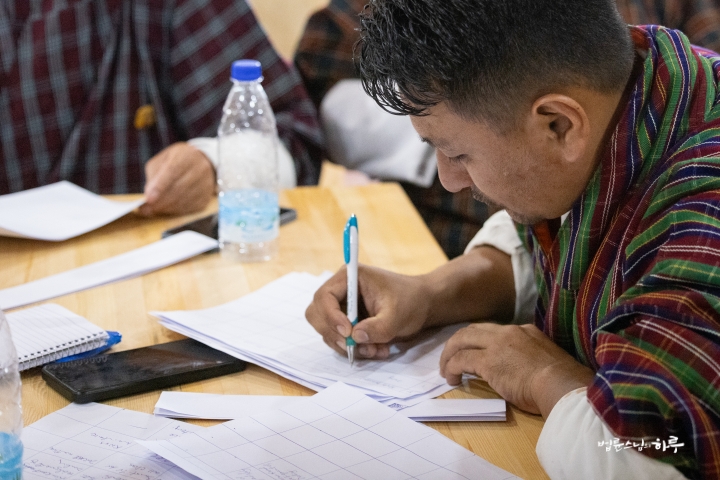
After an hour of discussion, they gathered again to present the results. The discussions became even more heated as they planned immediate actions. The chogpas neatly wrote down their pilot project plans on a single sheet of paper.

At 5 PM, everyone gathered again to present the plans for each chiwog and receive feedback from Sunim. After long discussions and reviews, final decisions were made on what pilot projects to implement for each chiwog. The chogpas presented their plans in a well-organized table, including project details, duration, and the number of households participating.

The chogpas planned various projects including building houses for the poor, securing water supplies, creating agricultural waterways, repairing health centers, paving sections of roads, renovating school toilets, building fences to keep out wild animals, supporting tents for traditional events, building retaining walls to prevent landslides, preparing traditional dance costumes, and setting up fire prevention water facilities.

Sunim reviewed each plan one by one. Smiling at a chogpa who had made too many plans, Sunim said:

“This is for pilot projects until May next year, but you’ve planned too much. So please remove the cultural and healthcare fields from the pilot projects. In terms of priorities, first is improving the housing environment for the poor, second is creating agricultural waterways, and third is securing drinking water. We should focus on these three and gradually work on the rest. But you’ve planned to build three houses by May next year – isn’t that too many? Can you do it? You can’t just do the construction; the villagers need to participate.”
“The villagers have already agreed to everything.”
“Did you tell them that JTS will provide materials and professional skills, but the villagers need to work together?”
“Yes, we told them all that.”
“Even so, do you think you can build three houses in one village by May next year?” (laughs)
“After you visited last time, we had a meeting with the villagers. When we told them that the monk from Korea would provide all the materials and we just need to do the work, everyone said they would do it. The villagers initially wanted to build eleven houses, but we reduced it. We’ve never had such support before. They said if you provide the support, everyone will work.”
“I see.” (laughs)

Everyone was very enthusiastic. The presentation time ended with a big round of applause.


Immediately after, from 6:40 PM, Sunim gave closing remarks to wrap up the second day of the workshop.
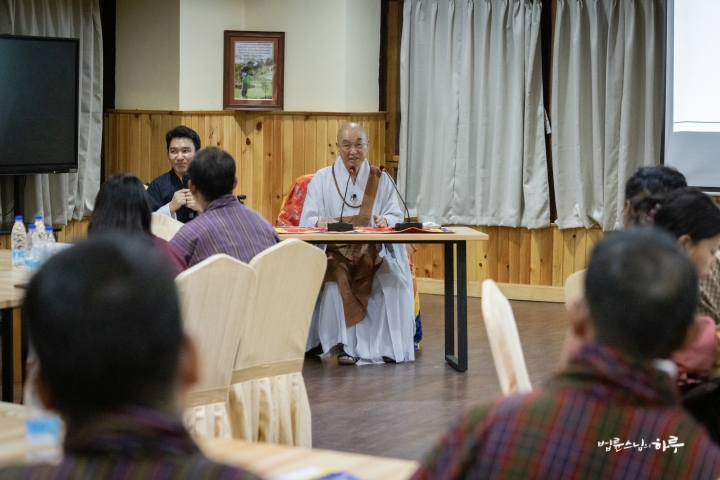
“Even though you seem to understand everything when you hear the explanation today, you might still get confused about JTS principles when you actually start working. (laughs)

The most important things are, first, to accept this project as ‘my work’ with a sense of ownership. You should approach this project with the mindset of ‘Let’s build our village ourselves’ and ‘Let’s create a new village.’ Second, you can propose anything at any time if it’s for the convenience and benefit of the residents. Third, when spending money, you should always be frugal. Simply put, because it’s Buddha’s money, you shouldn’t use it carelessly. You’re all Buddhists, so you know the term ‘Sambo Jeongjae’ (pure wealth of the Three Jewels), right? It means that using the Sangha’s wealth carelessly is a great sin. At JTS, we teach all activists not to use money carelessly. That’s why I always travel on low-cost airlines and, when possible, use budget accommodations rather than good hotels to save money.

To Expand the Pilot Project Throughout Bhutan
“If all the current pilot projects succeed, this project will expand to the entire Zhemgang district in the future. The success of the sample projects is necessary for the main project to proceed, and the success of the main project is essential for it to spread throughout Bhutan. The central government is also very interested in the results of the pilot projects. Since many people are watching with interest, let’s all work together to successfully carry out the pilot projects. Thank you all for your hard work.”

Following this, dinner and a social gathering began at 7 PM. First, Bhutanese officials and village leaders came forward to show Sunim traditional Bhutanese dances and songs.


Then, one by one, they expressed their gratitude to Sunim and sang a song each. As we clapped hands and sang together, we could deeply feel the affection for our colleagues who are moving towards the same dream.

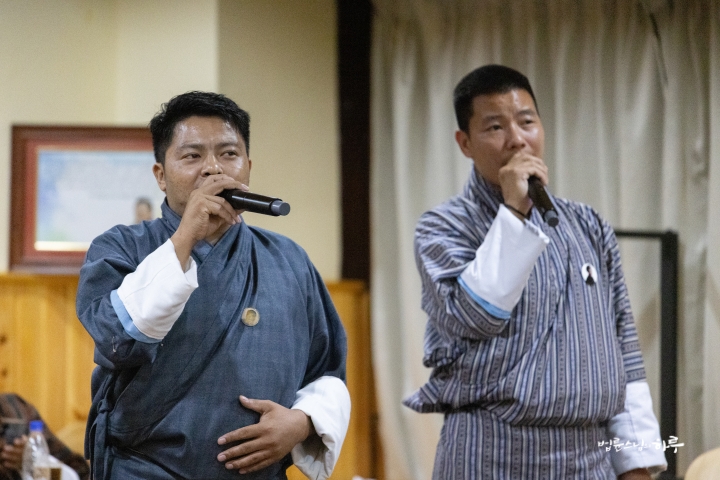

Sunim bid farewell to the participants, telling them to “stay and enjoy more comfortably,” and at 9 PM, he moved to his accommodation. After proofreading manuscripts and attending to some work, he retired for the night. The participants returned to their respective accommodations only at 10 PM.

Tomorrow is the third and final day of the JTS workshop. In the morning, after sharing reflections and holding a closing ceremony, there will be a Dharma Q&A session with students at Yebilaptsa High School in the afternoon, with interpretation in Bhutanese. In the evening, the plan is to move to Trongsa.




